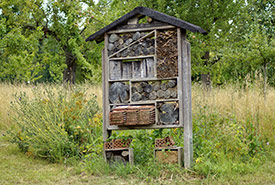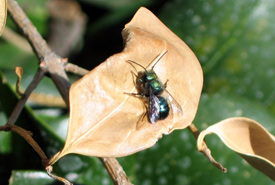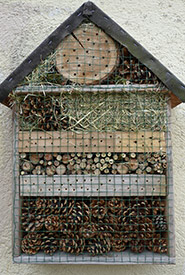Open for business: Make your own insect hotel

An insect hotel (Photo by Marzena7 CC0)
Many insects and their relatives, such as ladybugs, wild bees, beetles and spiders, require shelter. Make your backyard or green space open for vacancy by making an insect hotel!
Similar to a bee hotel, an insect hotel helps provide shelter for insects. It can be built big or small and can perfectly accommodate smaller urban gardens, such as balconies.
Follow the steps below to create your own insect hotel.
Step one: Determine the size of your hotel
Measure out the spot where you plan to put your hotel. This will help determine how much material you will need to build and fill the hotel.
Step two: Gather your materials

Blue orchard bee (Photo by Robert Engelhardt)
You can either make the structure of your hotel yourself using durable, weather-resistant material, such as wooden planks, or reuse something such as an old wooden box, planters or a few tin cans. I prefer recycling a structure that I have on hand. Once you have your structure, you will need these materials to make the inside of the hotel suitable for insects:
- bamboo, wood or hollow sticks
- twigs, natural cotton, pine cones, leaves or tree needles
- shredded newspaper
Different species require different types of materials to nest in. For example, bamboo, hollow sticks and drilled wood are great for solitary bees to burrow into. Twigs and other materials packed closely together provide ideal habitat for ladybugs to nest in.
Step three: Putting it all together

A completed insect hotel (Photo by Baba Mu CC0)
To learn about the bugs in your backyard, try using iNaturalist.ca. The app can help you identify the species in your backyard through photos taken with your phone. By identifying your guests (the bugs), you can ensure the rooms you built are suitable.
Pack your structure with the appropriate materials as listed above. To attract beetles, centipedes and spiders, try using dead wood, twigs and loose bark. Bamboo and hollow sticks are great for solitary bees.
If you can hold the structure upside down without the contents falling out, your hotel is ready to be installed. The appearance of your hotel isn’t as important as where you put it.
The area around your hotel is important too. In addition to building a place for insects to nest in, try planting a variety of native flowering plants that bloom at different times of the year. This will help attract pollinators and other species to your garden. Avoid herbicides and pesticides on your plants, especially those near the hotel.
Now it’s time to display your vacancy sign. You’re open for business!


